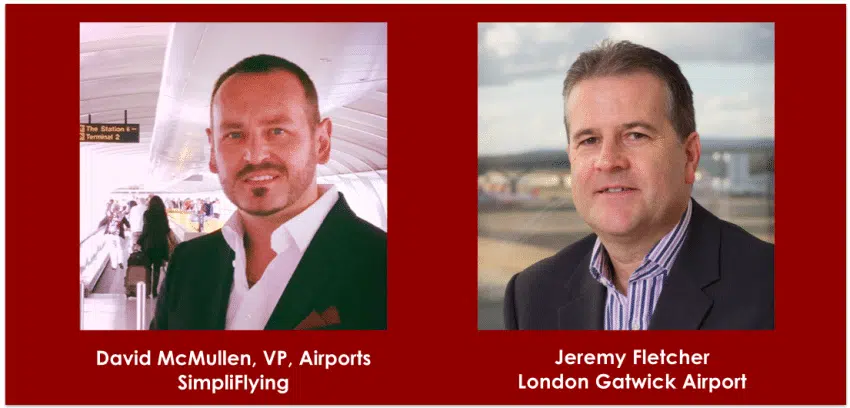Editor’s Note: This article was published in the Airport Marketing Exchange column in Airport World magazine (2014 Issue 1). Airport Marketing Exchange is a regular column by SimpliFlying to elucidate key issues and address how airports can plan their marketing and communications strategy to affect and measure results. Download the pdf of this article here
Today’s airport business and the modern multi-channel environment that we live in allow airports to collaborate effectively with passengers and potential passengers on brand strategies.
David McMullen, Vice President of Airports at SimpliFlying talks to Gatwick Airport’s Jeremy Fletcher about the implications of Gatwick rebranding itself as ‘London’s airport of choice’, the process behind it and how integrated communication efforts are used in pursuit of these goals.
A reality check on branding
We are witnessing many established airport brands repositioning to better meet customer needs. Why did Gatwick feel the need for change?

Indeed, it is important to find out what the current brand perception is before further action. Tell me, what is the new brand direction at Gatwick now?

The relationship between airport brands and their customers
Speaking of touch points, new media channels and social networks have loosened control over brand messages. We always advise our clients to put in place measures to stay connected to the consumers and ensure the consumer can have an active role to play as well.

Of course, the relationships between brands and their customers have now become more open-ended as online discussions extend the brand experience before and long after the ‘travel phase’ of the traveller’s lifecycle. Social media is especially valuable in capturing customer insights relating to brand position.

In the case of Gatwick, how do you see social media helping the airport to gain competitive advantage over neighbouring airports – or even competing European or global airports?

Effective marketing is critical to creating a successful airport. Increasingly over the last 12 months, customer intimacy and loyalty are common topics when we speak with airport CEOs. Airports need to establish a market position based on understanding the market and competition, whilst appreciating the dynamics of the airline industry. They can actively define this or passively permit the market to create the position.
Competing airports also define your position in the market – particularly with a strong network of brand ambassadors on social media. Airports like Gatwick have recognised that the perceptions of both can be shaped by your own marketing strategies.
If we look at the London region as an example, Gatwick has six rival airports and even competes with the Eurostar on European routes, not forgetting the fierce competition from other UK runways like BHX & MAN. Social positioning will become key to an airport’s success.
Through our ongoing research we’re already witnessing that 52% of global airports are focusing on air service development/ passenger development in their social media campaigns.
Knowing what matters in airport marketing
When creating or re-energising a brand, it is vital that airports understand where they are – relative to other airports and/or other industries – to measure the impact of their efforts. How successful has Gatwick’s social media strategy been in becoming ‘London’s airport of choice’?

How does Gatwick measure the impact from their branding and customer service initiatives such as the live Twitter chats? Fletcher: Seeing the involvement and responses to Twitter, alongside our ever-increasing social media followers, allows us to identify where we are making an impact. It is vital that we are constantly engaging and evolving to ensure we stay ahead of the game.
Success comes with dedication
Training is often overlooked by many organisations, especially in social media. In our recent survey with 46 global airports, although the majority invest in at least one day of social media training, it is clearly not enough if they want to achieve business goals effectively.

It is very encouraging to see how Gatwick uses ‘social photography’ to drive the footfall of travel retail and energise sales even further. We see revenues becoming an important business goal to be driven on social media for airports very soon.

It begins with spearing the awareness about how consumers have evolved to become connected travellers today.
At SimpliFlying, we developed a lifecycle that identifies key stages and objectives of the connected travellers. This helps airports and airlines understand where the windows of opportunities lie, be it for brand awareness or selling. Compared to airlines, airports are just starting to catch up to this phenomenon. Fortunately, there are a handful of airports such as Gatwick that have showcased innovative marketing.
As we work alongside some of these leading airports to inject fresh perspectives, we seek to extend our knowledge and expertise to more in the aviation industry to help them think differently in this age of connected travellers.
Download the pdf of this article here
###
Join in the #AirportMarketingX conversation!
Have a burning question that you’d like to ask about airport marketing?
Have an airport or executive in mind that you’d like to see in our series of ideas exchange?
We welcome your feedback and questions! Just tweet us at @simpliflying with the hash tag #AirportMarketingX, or leave us a comment on this blog post. The age of the connected traveller will be an exciting period not only for airlines but airports as well. Join us in the discussion today!

